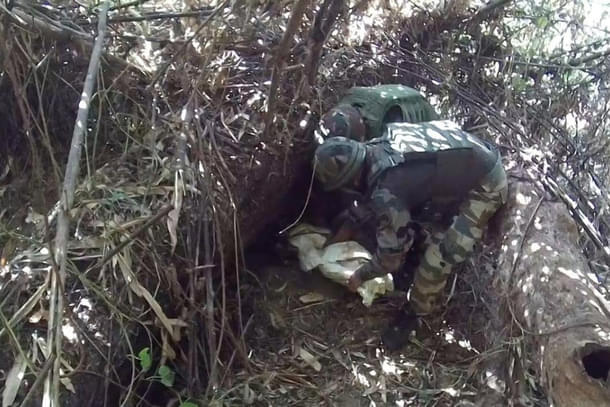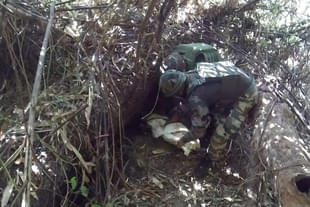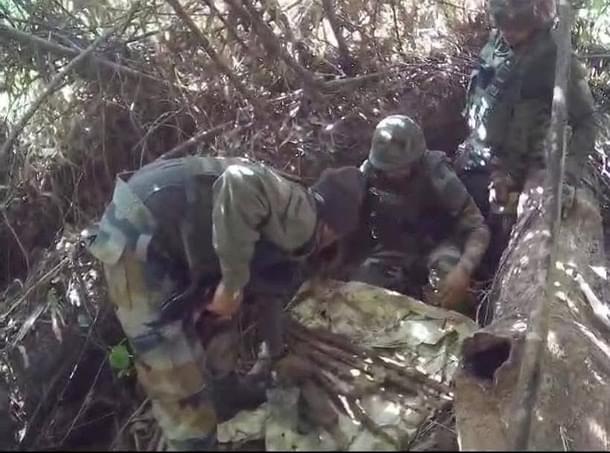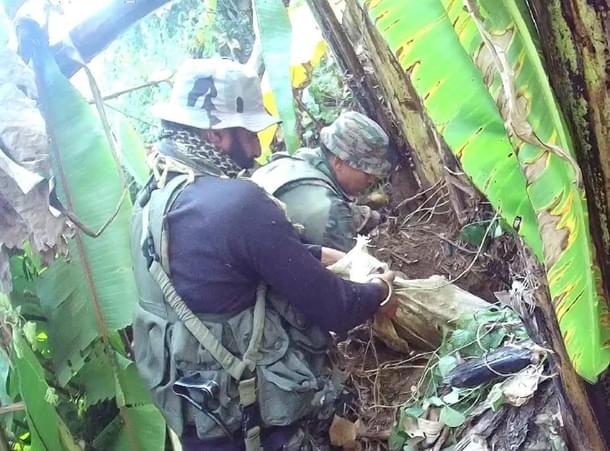North East
Swarajya Exclusive: How Indian Security Forces Trumped Naga Insurgents In An Unusual ‘Treasure Hunt’ In A Tiger Territory
Jaideep Mazumdar
Jan 02, 2025, 01:52 PM | Updated 01:51 PM IST
Save & read from anywhere!
Bookmark stories for easy access on any device or the Swarajya app.


The year 2024 ended on a high note for a large group of Indian Army and Assam Rifles officers and men.
They had just beaten two fierce factions of one of North East India’s oldest insurgent groups, the National Socialist Council of Nagaland (NSCN), in an unusual ‘treasure hunt’ inside a dense forest that’s also a tiger habitat.
The ‘treasure’ was a cache of 10 deadly Chinese-made MQ-81 assault rifles buried deep inside the dense Namdhapa National Park and Tiger Reserve in Arunachal Pradesh’s Changlang district.
The operation was launched about seven months ago (sometime towards the end of June last year) when credible information emerged about sophisticated assault rifles lying buried somewhere in the Namdhapa forest, which straddles upper Assam and southeastern Arunachal Pradesh.
The intelligence cells of the Indian Army’s 3 Corps (also called the ‘Spear Corps’), headquartered at Rangapahar in Nagaland’s Dimapur, and the Assam Rifles’ Inspectorate General (North), located in Nagaland’s capital Kohima, had been working on inputs that a good number of assault rifles had been buried inside the Namdhapa forest by a militant outfit in early 2023.
The leadership of this little-known outfit, the Eastern Naga National Government (ENNG), had surrendered in March 2023 and subsequently merged with the dominant Isak-Muivah faction of the NSCN (the NSCN-IM) in January 2024.
“We got to know that the ENNG had buried some rifles in eastern Arunachal Pradesh before surrendering in March 2023. We were determined to recover those since we didn’t want them to fall into the hands of other militants,” a senior officer of the Spear Corps told Swarajya.
Inputs about the location of the cache started coming in sometime towards the middle of 2023, but they were vague at that time. Army and Assam Rifles officers then started coordinating with each other and working on their respective ‘sources’ to gather more information about the arms cache.
After painstaking efforts, the Assam Rifles, which draws most of its middle-rung and all of its top-rung officers from the Indian Army, got credible information in April-May last year that the weapons were buried in the portion of Namdhapa forest within Changlang district.
This information was shared with the Spear Corps leadership, and it was decided to launch a joint operation to unearth the ‘treasure’.
At the same time, Army and Assam Rifles officers also learnt that the NSCN (I-M) and its rival faction, the NSCN (Khaplang-Yung Aung), or the NSCN (K-YA), had launched simultaneous bids to recover the rifles.
The NSCN (IM) had a significant advantage not only over its rival NSCN (K-YA) but also over the Army and Assam Rifles because it knew the precise locations of the buried treasures.
The leaders of the ENNG, which had merged with the NSCN (IM), gave out the location of the buried rifles to the NSCN (IM) leadership.
But a few mid-ranking men of the ENNG, who defected to the NSCN (K-YA) in 2023, also knew about the buried rifles. They informed the NSCN (K-YA) leadership about the buried treasure.
The Spear Corps headquarters received information that both factions of the NSCN had launched efforts to unearth the treasure. Hence, urgency and quick, coordinated operations by the Army and Assam Rifles assumed importance.
Ultimately, by deploying a variety of tactics and technology, the combined team of the Army and Assam Rifles, who were also helped by the Arunachal Pradesh police, zeroed in on all the spots inside the forest where the rifles had been buried nearly two years earlier (sometime in January-February 2023).

The History of This ‘Treasure’
When the top leadership of the ENNG, a militant outfit operating in the eastern Arunachal Pradesh districts of Tirap, Changlang, and Longding, surrendered to state Chief Minister Pema Khandu in March 2023 along with arms, security forces heaved a collective sigh of relief.
Formed in January 2016, the ENNG was responsible for abductions for ransom, murder, and other violent activities, including armed battles with the Indian security forces.
The ENNG is believed to have received arms, ammunition, and training from China through its surrogates in Myanmar’s northern Kachin state, which also borders China’s southwestern Yunnan province.
Fifteen top cadres of the ENNG, led by its chief Tosham Mossang and comprising self-styled ‘colonels’ Chopsai Pangsa and Wangjen Pangtha, ‘major’ Daniel Sankey, ‘captains’ Maithangla Tikhak, Netra Kumar Rai, Limpha Khimsing, Khunglun Mossang, and Bainong Mungrey, ‘lieutenants’ Monpi Mamai and Samhon Songthing, ‘second lieutenant’ Lungphang Jugli, and ‘sergeants’ Wangwa Hatum and Hemraj Pradhan, surrendered before Chief Minister Khandu.
The ENNG militants deposited nine Chinese-made MQ series rifles, two AK-47 rifles, one Chinese-made pistol, 19 magazines, 415 rounds of 7.62 mm ammunition, five rounds of 9 mm pistol ammunition, four Chinese-made grenades, one under-barrel grenade launcher, and six walkie-talkie sets during the surrender ceremony.
The ENNG leadership assured the security forces, including then-Major General Vikas Lakhera, who was the Inspector General (North) of the Assam Rifles at that time — he is now a Lieutenant General, and took over as the director general of the Assam Rifles in August last year — that they had deposited all the arms and ammunition that were in their possession.
But some Assam Rifles officers were sceptical and kept monitoring Mossang and his associates. “We knew that the ENNG had a much larger armoury. Our intelligence indicated that they had hidden a part of their armoury somewhere. After the surrender, we questioned them, but they insisted that they had surrendered all their arms,” a senior Assam Rifles officer of the rank of Brigadier told Swarajya.
These suspicions were also shared by senior officers of the Spear Corps. The army’s intelligence also mounted a vigil on Naga militants.
The suspicions of senior officers of the Army and Assam Rifles were confirmed in January last year when the ENNG merged with the dominant NSCN-IM. The NSCN-IM has been engaged in peace talks with the Government of India since July 1997.
At the merger ceremony on 27 January last year, ENNG chief Mossang and 30 others of his outfit, including the ones who had surrendered before Chief Minister Khandu in March 2023, were present along with arms.
“As per our intelligence, the ENNG ‘leaders’ had AK-47 and MQ-81 assault rifles and other Chinese-made small arms in their possession during the merger ceremony,” a senior staff officer of the Spear Corps told Swarajya.
“That led us to believe that they have arms caches stacked away in some places. Months of surveillance, including eavesdropping on conversations between the seniors of the NSCN (IM) and ENNG revealed that one arms cache was hidden in the Namdhapa National Park,” he added.
The Operation
Once the approximate locations of the buried rifles were obtained, the Army and Assam Rifles stepped up patrolling on the roads and highways in the entire contiguous area comprising Upper Assam, northern Nagaland, and southeastern Arunachal Pradesh.
“The objective was to deny the NSCN groups the advantage that they had over us — knowledge of the precise location of the buried arms. We were determined to stop their free movement in order to thwart their bid to recover the arms,” a top officer of the Spear Corps, who coordinated the search and recovery operation, told Swarajya.
Apart from patrolling the roads in the entire area covering the three states, vigil was mounted on tracks in remote areas that the Naga militants are known to use. “We ensured that the Naga militants could not get anywhere near the areas where the rifles lay buried,” the officer added.
“We had also stepped up our HUMINT (human intelligence) ops to get the precise locations of the buried arms. But despite our best efforts, we only got their vague locations. So we deployed specialised drones that can operate inside thick forests and detect metallic or other objects to locate the arms,” the Spear Corps officer said.
Breakthroughs in locating the buried rifles were achieved by the end of the third week and beginning of the fourth week of December.
Once the locations came to be known, Army and Assam Rifles teams, equipped with metal detectors and accompanied by sniffer dogs, ventured deep into the Namdhapa forest to dig up the rifles.
Initially, the sniffer dogs were ineffective because they were overwhelmed by the smell of wild animals in the forest. Also, the dense forest presented an unfamiliar working environment to them. It took a lot of coaching and some additional training by their handlers to get the dogs to work effectively inside the forest.
It was a difficult operation, fraught with dangers. “Our men had to be careful and watch out for booby traps and possible ambushes laid by the NSCN militants inside the dense forest that’s also inhabited by wild animals, including tigers and bears,” said the Assam Rifles Deputy Inspector General (as Brigadiers are designated in that force).
Also, the presence of tourists and wildlife enthusiasts in the fringe areas of the reserve forest posed an additional hurdle.
The state police were requested to clear the entire area of outsiders and also warn local villagers against venturing into the forests to collect forest produce or hunt animals.
“Even after we got to know about the locations of the hidden arms, we had to lie low for a few days to give the police enough time to clear out the outsiders (tourists and visitors) from the forest and ensure that no local villagers were venturing into the forest,” said the Assam Rifles officer.
Ultimately, in the middle of the fourth week of December, the final operation to unearth the rifles was launched and the ‘treasure’ was recovered.

But the security forces haven’t declared complete victory yet. There are lingering suspicions that the ENNG had buried more rifles inside the Namdhapa forest or in other areas of the three southeastern districts of Arunachal Pradesh (Tirap, Changlang, and Longding).
“We are gathering more information and may launch searches again if we get some solid leads,” said the Spear Corps officer.





